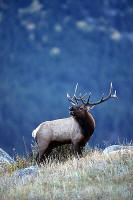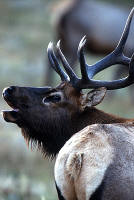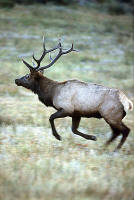Giving Wildlife the Room to Live
by Lonnie Brock



Don’t Feed the Animals
How Close Can I Go?
Respect All Bears
Only Bears Are Dangerous?
Children and Wildlife
Along the Road
Photographing Wildlife
Introduction and the Problem:
We all share the responsibility for our own safety, that of those around us and that of animals that we observe or photograph. Inappropriate behavior can lead to confrontations that result in injury or death either to the animals or people. Visitors to our public lands need to be aware that their actions can lead to severe stress for animals and that an animal that feels pressured may react aggressively. Such behavior is the animal’s only form of communication and protection. It is important to understand the necessity of observing and photographing wild animals from a safe distance, as well as the negative impact of feeding them. As you read through this section, remember that it is meant to help you become more knowledgeable about wildlife. Help others obtain a better understanding of how to protect animals while enjoying them.
Don’t Feed the Animals:
We have all heard that feeding animals can put us and our friends in danger. However, every time we visit a park or similar area, we still see people feeding the wildlife. Being fed can also be harmful to the animals:
- Animals that are fed along roads tend to frequent road edges for handouts. This can result in animal-vehicle accidents.
- Animals that become accustomed to human food may eat aluminum foil, plastic, and other wrappings. This can severely damage their digestive systems, often causing death. A few years ago, several deer at Grand Canyon National Park were put to death because they had ingested plastic bags while searching for human food and the bags had clogged their stomachs.
- Most animals’ digestive systems are not suited for human food. Poor diet results in tooth decay, ulcers, malformations, arthritis, and other diseases.
How Close Can I Go?
Wild animals should always be allowed to carry out their normal behavior without interruption. That is the key thought to remember. If an animal moves away from you, turns its back towards you, stops eating, changes direction of travel, stands when it is resting, or becomes aggressive, you have gotten too close. In many of our public lands, there are local regulations on the safe distance to maintain from the local wildlife that should certainly be heeded. However, every situation is different and posted regulations are no guarantee of safe distances. You should certainly use common sense and observe what the animal is telling you.
Wild animals that have been approached too closely, have:
- Been startled and run into traffic where they have been hit by vehicles.
- Lost footing on cliffs and fallen.
- Fled suddenly and suffered injury or death while trying to escape.
- Been separated from their young or abandoned their nest.
- Been distracted from watching for predators.
- Acquired a human scent track that can lure predators to nests or young.
- Abandoned an important food source, reducing their chances for survival.
- Responded aggressively without warning, posing a danger to those watching them.
Respect All Bears:
When in bear country, make your presence known, by talking loudly, clapping your hands, or occasionally calling out. A favorite with the rangers in Glacier National Park is to periodically call “Hey, Bear” as one roams down the trails of the park. The key is to be heard and not surprise the bears. Some important bear facts to remember are:
- All bears can run as fast as horses, both uphill and down.
- All bears can climb trees, some better than others.
- A bear’s eyesight is much better than most people believe. Don’t be fooled.
- Avoid direct eye contact. It is often interpreted by bears and other animals as a challenge or threat.
- A bear standing on its hind legs usually wants a better view and only wants more information.
- On four legs, a bear may show agitation by swaying its head from side to side, making huffing noises, and clacking its teeth.
- A charge or retreat may follow. Flattened ears and raised hair on the back of the neck indicate aggressive intent. If a bear runs with a stiff, bouncing gait, it may be a false charge.
- Never run away from a bear. back away slowly.
Because of their size and reputations (often the result of popular fiction), bears are a special case. A bear that shows aggression towards public land visitors or accepts food will be destroyed because of the possible threat to public safety. Help protect the bears, when in bear country:
- Stay informed about recent bear activity in the area.
- Leave a travel plan with a friend, and sign in and out at the trailhead so someone will know when to expect your return.
- Hike in groups to avoid surprising bears.
- Hike during daylight hours only.
- Make human sounds by talking, singing or clapping your hands. Avoid high-pitched voices.
- stay alert and be aware of your surroundings. The potential for a bear encounter always exists. Watch for droppings, paw prints, fresh diggings, logs torn apart , and rocks turned over. these signal that a bear is active in the area.
- It is easy to become absorbed in your photography – stay alert and stay alive.
- Bear food supplies such as berries, spawning fish, and animal carcasses should be recognized and avoided.
- Watch for noisy streams and wind directions that may mask your sound and scent.
- Just because you don’t see bears doesn’t mean that they are not close by. Grizzly bears hide ro make day-beds in thick brush, often near trails.
- always carry a used bandana, shirt or parka that you can drop easily if you have a close encounter with a bear. Avoid dropping food, this will only encourage the bear’s aggressiveness towards other hikers.
Only Bears Are Dangerous?
Bears seem to get the most media attention when they are involved in confrontations with people. However, other wild animals have been involved in more confrontations that lead to serious injuries and fatalities. Keep this in mind the next time you see anyone approaching wildlife. In all species, both females and males are potentially dangerous.
Many public land animals have become accustomed to people and unfortunately will allow people to come very close before responding. This does not mean they are tame, like pets or farm animals, but that the safe distance between the people and the animals has decreased. This only means that when flight or fight is chosen, a retreat to a safe distance for people may be too late. The animal has less time to determine whether to fight or flee when it feels threatened. When it does choose, a visible warning is not always apparent.
Some specific thoughts, but not an all-encompassing list of possible dangers:
- Buffalo may look slow but are actually very fast and have short tempers. Buffalo will stomp, use their horns and their massive body weights to gore or otherwise injure what they consider to be a threat.
- Moose will charge – running, kicking and stomping – when they feel threatened. It only takes a small provocation, like a person’s approach, a dog barking or the scent of a coyote, to change a passive moose into a dangerous moose.
- Deer can cause injuries and sometimes death by kicking and using their antlers without warning. Keep a safe distance.
- Bighorn sheep and mountain goats will butt people, breaking bones and inflicting puncture wounds. This is a normal form of communication for them. Your only protection is to keep a safe distance.
- Chipmunks, squirrels, rabbits, foxes, raccoons, and other small animals can carry rabies and Rocky Mountain spotted fever. They also can inflict painful scratches and bites prone to infection.
- Many birds will abandon eggs or young in the nest if disturbed by people approaching.
- All animals are especially dangerous during their mating season. This includes relatively harmless looking birds, like hawks, swans and herons.
- Never surround any animal with a group of people. A startled animal may charge right through the group, inflicting injury on its way.
Children and Wildlife:
Teach you children how to protect wildlife by protecting themselves. Wild animals, unlike those encountered in petting zoos or farms, pose special dangers:
- Children are similar size to some predators’ natural prey.
- Children should always be within immediate sight and reach.
- Children should be told not to play in or near dense brush.
- Children should avoid running along trails or areas with dense brush.
- Children should not make animal-like sounds while hiking or playing.
- Children should be warned not to approach animals, with special warning about baby animals.
- Children should never be encouraged to pet, feed or pose for a photo with animals in the wild – even if they appear tame.
Along the Road:
- Allow animals to cross the road unobstructed.
- Animals often travel in pairs or groups. If one runs in front of you, watch for others to follow.
- Do not lure animals to your car with food or throw food at them. This encourages them to frequent the road area.
- Observe or photograph animals, especially bears, from your car. Do not drive close to animals. Many animals can and will cause serious damage if they feel threatened by the presence of your vehicle.
- Do not park on the roadway. Always park in turnouts.
- Always observe local regulations and common sense.
Photographing Wildlife – Purchasing a Camera Does Not Give Anyone the Right to Put Animals, Birds or Marine Life Under Stress!
- Wildlife should only be photographed from a vehicle, an observation area, or with an adequately long lens (in most cases 400mm or longer).
- Remain alert to potential dangers in your eagerness to make the perfect image; 500 to 1,000 feet is recommended to avoid provoking large animals.
- Never surprise an animal. Retreat at any sign of stress or aggression.
- Avoid direct eye contact, even through the lens.
- Don’t crouch or take a stance that may appear aggressive to a wild animal. Avoid following or chasing as the animal may respond by charging.
- Never try to herd an animal to a different location.
- Don’t make sounds of any kind to startle or gain the attention of an animal.
- Never surround or crowd an animal.
- Avoid occupied dens or nests.
- Watch other people in the area. Are they putting you or the animals in danger?
- Avoid dense brush.
How do professional photographers make great wildlife photos?
The easiest , and possibly the safest, way to find wildlife and make great images may be visiting captive animals at wildlife game farms. If this approach is taken and the images are published, it is imperative that you disclose where they were made. There is some controversy among nature photographers as to whether captive animals are should ever be used. The arguments from both sides of this controversy are compelling, and only you can make your decision on this matter.
However, if photographing in the wild, there are two things that are needed for great wildlife images:
- The first is the proper equipment. Powerful telephoto lenses are a must. As noted above, if you are doing everything else correctly around animals, you should probably be using a 400mm lens or longer to photograph wildlife. That can be accomplished less expensively by renting longer lenses for special trips or by purchasing teleconverters for 200mm and longer lenses. In many cases, professionals are carrying 500mm or 600mm lenses and teleconverters, to be able to shoot at focal lengths of up to 1000mm or 1200mm. Although faster equipment does make the task easier, it is sometimes prohibitively expensive for the occasional use by an amateur, and I have seen many images made by our students with slower lenses that are excellent. Check to see if your manufacturer of choice makes an f/4 lens instead of an f/2.8 (there can actually be a few thousand dollars of difference in the cost) or if there is another manufacturer that makes a good all purpose zoom that has relatively long capabilities, although at slower speeds (good examples that we often see in the workshops include the Tamron 28-300mm f/5.0-6.3, the Tamron 200-400mm f/5.6 and the Sigma 170-500 f/5.0-6.3), or that makes a less expensive long fixed focal length lens (in this case, you may be able to buy an extra couple of hundred millimeters of length for the same money as a “name” brand). There seem to have been great improvements made in the lenses offered by so-called “second tier” manufacturers in recent times.
- The second, and absolutely necessary, thing needed is an abundance of patience. Although the rare spectacular shot may fall in your lap, don’t expect that to happen; many wildlife photographers have devoted years to making the desired image in a responsible manner. If you don’t believe you have the time to do this, you should probably be photographing something other than wildlife or be photographing habitat images (wildlife at a much smaller size within the image that illustrates the animal in its environment). If you can’t make the image you desire in an ethical manner, be happy to have simply witnessed the majestic creatures in the wild. Being a part of nature is more important, and hopefully more satisfying, than any photograph you can ever make. We are all stewards of the natural world.
